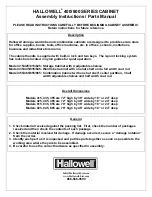
Rev. 1.10
88
November 26, 2019
Rev. 1.10
89
November 26, 2019
HT68FB240
USB Low Speed Flash MCU
I
2
C Bus Communication
Communication on the I
2
C bus requires four separate steps, a START signal, a slave device address
transmission, a data transmission and finally a STOP signal. When a START signal is placed on
the I
2
C bus, all devices on the bus will receive this signal and be notified of the imminent arrival of
data on the bus. The first seven bits of the data will be the slave address with the first bit being the
MSB. If the address of the slave device matches that of the transmitted address, the HAAS bit in the
SIMC1 register will be set and an I
2
C interrupt will be generated. After entering the interrupt service
routine, the slave device must first check the condition of the HAAS bit to determine whether the
interrupt source originates from an address match or from the completion of an 8-bit data transfer.
During a data transfer, note that after the 7-bit slave address has been transmitted, the following bit,
which is the 8th bit, is the read/write bit whose value will be placed in the SRW bit. This bit will be
checked by the slave device to determine whether to go into transmit or receive mode. Before any
transfer of data to or from the I
2
C bus, the microcontroller must initialise the bus, the following are
steps to achieve this:
• Step 1
Set the SIM2~SIM0 and SIMEN bits in the SIMC0 register to "1" to enable the I
2
C bus.
• Step 2
Write the slave address of the device to the I
2
C bus address register SIMA.
• Step 3
Set the SIME and SIM Muti-Function interrupt enable bit of the interrupt control register to
enable the SIM interrupt and Multi-function interrupt.
I
2
C Bus Initialisation Flow Chart
I
2
C Bus Start Signal
The START signal can only be generated by the master device connected to the I
2
C bus and not by
the slave device. This START signal will be detected by all devices connected to the I
2
C bus. When
detected, this indicates that the I
2
C bus is busy and therefore the HBB bit will be set. A START
condition occurs when a high to low transition on the SDA line takes place when the SCL line
remains high.
















































